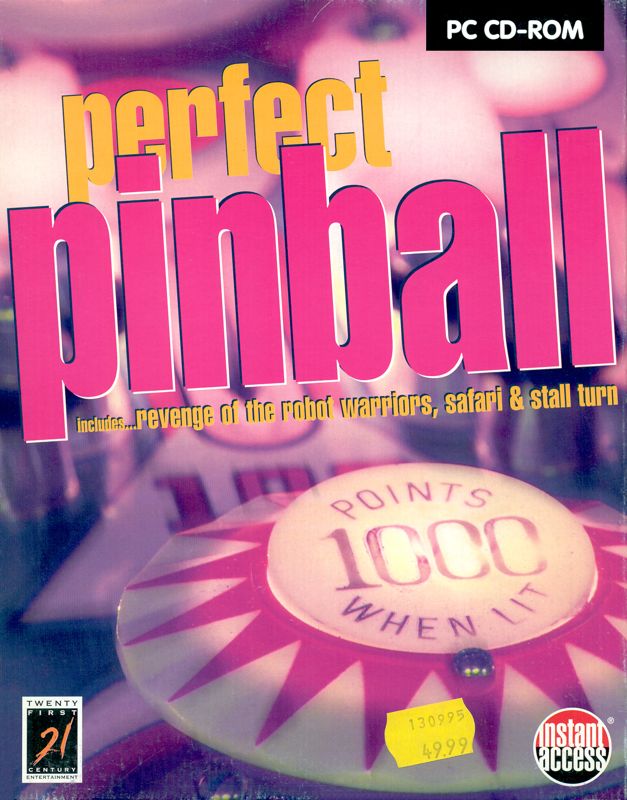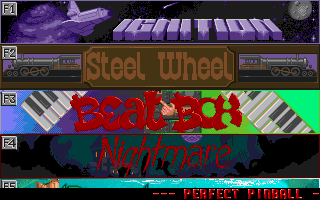Retro Replay Review
Gameplay
Perfect Pinball offers a classic pinball simulation that feels both nostalgic and surprisingly robust for its 1995 release. Players start with three playable tables—Safari, Stall Turn, and Revenge of the Robot Warriors—each drawn from the Pinball Dreams series. The physics engine captures the satisfying clang of bumpers and the unpredictable bounce of the steel ball, making each table feel unique and rewarding to master.
While the core experience shines in its faithful recreation of traditional pinball mechanics, the game’s business model adds an unconventional twist. Six additional tables from Pinball Dreams, Pinball Dreams II, and Pinball Fantasies are locked behind a purchase system accessible through the Instant Access browser. Unlocking any table requires an £5–£12 payment by credit or debit card and an old-school phone call to retrieve an 18-digit code. This process can interrupt the flow for casual players, but for pinball enthusiasts it’s a small hurdle to access a wider variety of tables.
Controls are intuitive—keyboard and joystick support mean you can fine-tune your flipper timing and nudge the machine to rescue a wayward ball. Given the era’s hardware limitations, there’s no ball-tilt animation, but subtle screen shake and audio cues effectively simulate the tension of over-nudging. Additional options such as table-specific difficulty settings and adjustable tilt sensitivity give players a chance to tailor the challenge to their preference.
Graphics
Visually, Perfect Pinball presents two display modes: the original low-res VGA (320×200) and an enhanced SVGA option (640×350). On a period CRT monitor, the VGA mode exudes pixelated charm, with bold table art and vibrant colors that pop against the black playfield background. The higher-resolution SVGA mode smooths out jagged edges and reveals more intricate artwork details, making targets and ramps more distinguishable at a glance.
The three included tables benefit from carefully crafted backdrops and thematic decals—Safari’s jungle motifs, Stall Turn’s aviation cues, and Revenge of the Robot Warriors’ sci-fi elements each present distinct visual identities. The animations are simple but effective: flashing lights around bumpers, spinning targets, and short cutscenes when you hit multiball or special modes. It’s not flashy by today’s standards, but by mid-’90s DOS game norms, it holds its own.
Beyond the tables, the Instant Access browser has its own early-Windows 3.1 aesthetic, complete with gray-paneled windows and rudimentary buttons. It’s a reminder of the transitional era when DOS programs and Windows utilities coexisted. The inclusion of two audio tracks on the CD also allows for streaming background music via the PC’s CD-ROM drive, though mixing modes can occasionally lead to sync issues with the in-game sound effects.
Story
Perfect Pinball isn’t a narrative-driven title in the conventional sense, but it does tell the story of digital pinball’s evolution. By licensing tables from three different 21st Century Entertainment releases—Pinball Dreams (1993), Pinball Dreams II (1994), and Pinball Fantasies (1994)—it functions as a curated anthology of arcade-style tables. Players effectively experience chapters of pinball design history, from early mechanical themes to more elaborate sci-fi and party settings.
The most overt storytelling element is the “History of Pinball” feature, a built-in database tracing the development of physical pinball machines from their 19th-century origins to modern electromechanical marvels. Complete with archival artwork and descriptive text, it serves both casual gamers and pinball aficionados looking to deepen their appreciation for the medium. This educational extension elevates Perfect Pinball from a simple game compilation to a mini-museum exhibit.
Unlocking additional tables via phone and online activation becomes part of the game’s meta-narrative: it mirrors the old practice of mailing in coupons or dialing premium hotlines for arcade secrets. That quirky, analog activation ritual adds a layer of authenticity, reinforcing the feeling that you’re collecting rare pinball cabinets—even if you’re sitting at home with a 386 or early Pentium PC.
Overall Experience
Perfect Pinball occupies a unique niche as both a faithful pinball simulator and a period piece. Its three included tables deliver immediate value, while the option to purchase six more provides long-term playability for dedicated fans. The process of unlocking additional content may feel cumbersome today, but in 1995 it tapped into the emerging convenience of online distribution and credit-card payment for digital goods.
For enthusiasts of retro gaming and pinball history, the title’s combination of classic table design, versatile graphics modes, and the “History of Pinball” encyclopedia make Perfect Pinball a compelling purchase. Even casual players can enjoy hours of flick-and-flip action without spending extra, especially given the reasonable base price point in its era. Multiplayer hotseat mode adds a competitive edge for friends taking turns chasing high scores.
In sum, Perfect Pinball stands out as a well-executed homage to arcade pinball, offering solid gameplay, nostalgic visuals, and a rich contextual layer through its historical feature. Its minor quirks—namely, the old-school activation system and compatibility requirements—only reinforce its authenticity as a mid-’90s DOS and Windows crossover product. For anyone curious about pinball’s digital past or seeking straightforward table thrills, Perfect Pinball remains a worthwhile classic.
 Retro Replay Retro Replay gaming reviews, news, emulation, geek stuff and more!
Retro Replay Retro Replay gaming reviews, news, emulation, geek stuff and more!









Reviews
There are no reviews yet.